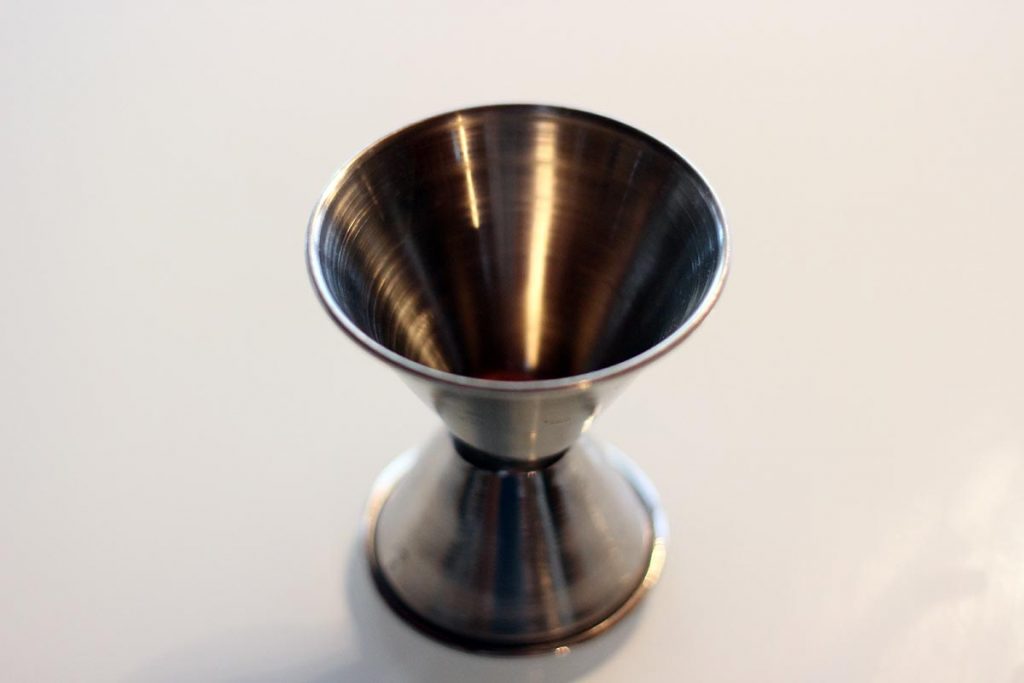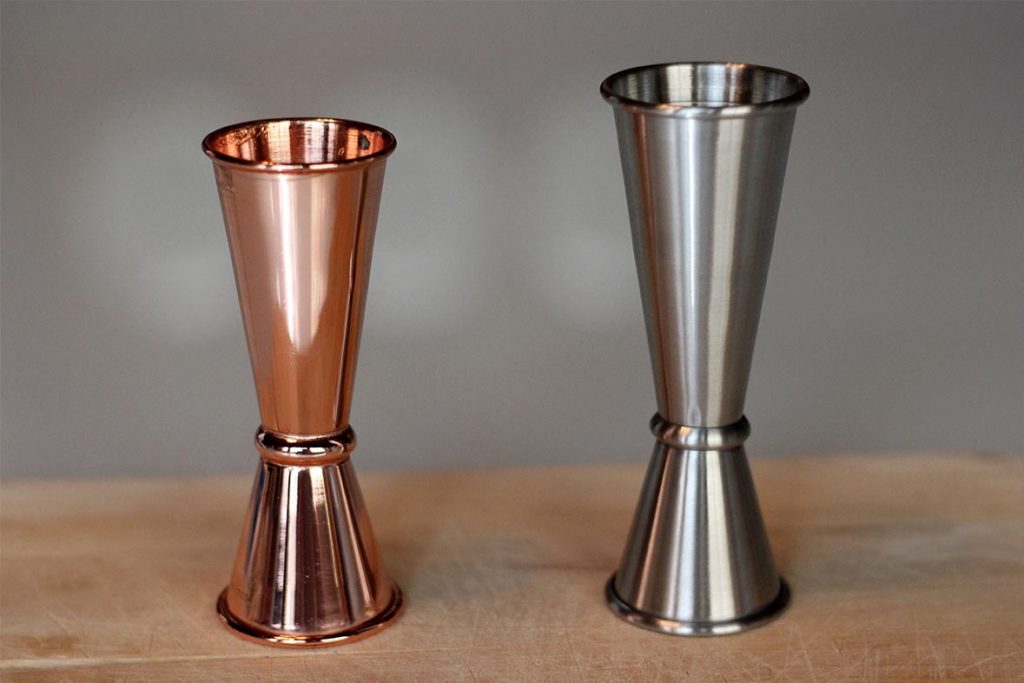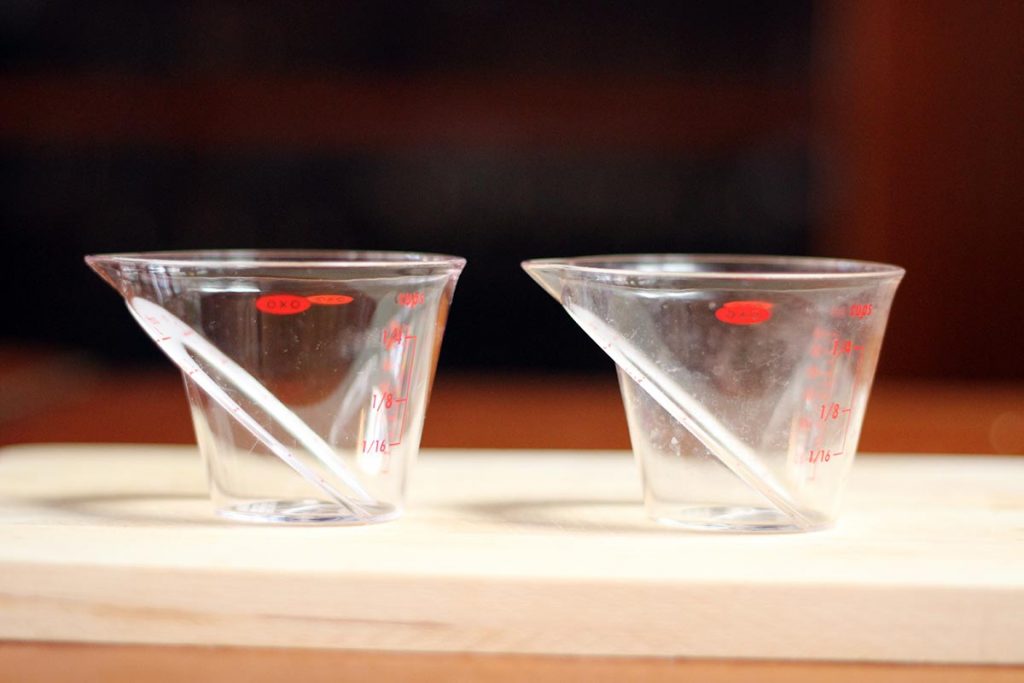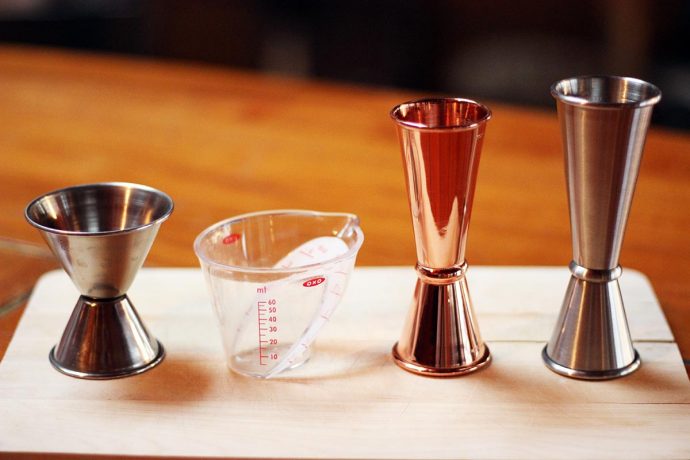The word “jigger” always gets funny looks from bystanders, but goofy name or not, it’s one of the most important tools in a bartender’s arsenal. These little hourglass-shaped gadgets are essential to getting your measurements right, especially when it comes to the level of precision required by today’s craft cocktails.
What is a jigger?
Basically, cocktail jiggers are just specialized measuring cups for booze and related ingredients. They’re typically double-sided (comprised of two conical cups of different sizes joined end to end), made of metal or plastic, and range in volume from a half ounce to two ounces.
We generally recommend using one that holds two ounces on the large side, as most craft cocktails use that volume for their base spirit (as compared to the standard one-and-a-half-ounce variety). The small side is a little less important, but one ounce will usually do the trick.
As far as the basics go, there’s not much more to say about them than that. You pour your ingredient into the jigger until it’s full, and then you immediately pour it out into the shaker, mixing glass, or serving glass you’re using to make your drink. Voila.
Why do I need a jigger?
If you spend enough time in bars, you’re bound to see a lot of bartenders making their drinks with what’s called a “free pour”—essentially measuring by hand, using silent counts to get the amounts right.
Most bartending schools will make you spend days practicing free pours, and professionals are generally very good at estimating measurements consistently.
Back in the day (and even still, in some places), people would be offended or disappointed if you measured out every ingredient with a jigger. As far as the customer could tell, you were trying to short them an extra little bit of booze, or at best, they’d assume you just had a stingy bar manager.
Today, though, particularly in craft cocktail bars, the jigger is seen as a necessity. We don’t want to bash old-school venues, but simple recipes like the Rum and Coke or Gin and Tonic (or the ever-popular “bourbon in a glass”) aren’t really ruined if you under- or over-pour a little bit.
When you’re making something more complicated, though, a quarter ounce really can make or break the final product. Sure, the impact is probably a bit overstated by cocktail snobs who want to impress you with their encyclopedic palate, but if you (or someone else) spent years perfecting a recipe, it’s worth it to try to recreate their work to a T.
Plus, if you’re a novice bartender (or simply don’t want to spend a week pouring water into measuring cups from an old vodka bottle to practice), using a jigger is a great way to ensure your drinks end up tasting the way they’re supposed to. And since it’s what the pros do anyway, nobody will know you’re a noob!
Which jigger do I get?
While jiggers are relatively simple implements, you still have a few options to choose from when you’re looking to buy one. These are the three basic categories on the market (there are other specialty products, but none that add all that much functionality) and our favorite ones from each:
Standard Double Jiggers
Standard double jiggers are the straightforward, no-nonsense choice. This is the kind of thing you’d be able to find in bars throughout the 20th century, and still can in most today. They’re usually made from stainless steel, and they’re pretty much indestructible. The only one we’ve ever broken was literally older than we were.

A standard double jigger. They pretty much all look exactly like this.
- OXO SteeL Double Jigger ($9) – As with so many bar tools, many people’s favorite is made by OXO. This one is very well made, and will probably outlive you. The only downside is that it maxes out at one-and-a-half ounces, but it makes up for it by having a lot more measurement lines than most for those really exacting recipes.
- Winco Jiggers Steel 1 Ounce x 2 Ounce Jigger ($4) – There are also the stupidly-inexpensive, old-school models that you can pick up for less than five bucks. This baby gets the job done without making you look like a showoff. Unfortunately, the wide-mouth cup can cause a bit of an issue with splashing and spillage if you’re pouring, uh, enthusiastically, so keep that in mind.
Japanese-Style Jiggers
Japanese-style jiggers are the trendy, refined cousins of the standard jigger. They’re taller and narrower, which reduces the probability of spillage. And perhaps most importantly, they look pretty sexy on your bar.

Two Japanese-style jiggers. Left: Cocktail Kingdom copper-plated Japanese jigger, 1.5/1 oz. Right: Cocktail Kingdom stainless steel Japanese jigger, 2/1 oz.
- Cocktail Kingdom Japanese Style Stainless Steel Jigger ($10) – Our preferred models come, as always, from Cocktail Kingdom. This one is as basic as you get with this style, and it works beautifully.
- Cocktail Kingdom Copper-Plated Japanese Style Jigger ($20) – As you may have seen elsewhere in this series, we have a bit of a soft spot for copper-plated bar gear. For those looking to splurge (relatively speaking), you can’t go wrong adding this spiffy piece to your collection.
Angled Measuring Jiggers
Angled measuring jiggers are the last category we’ll mention, and while it’s technically not a monopoly, OXO once again has a corner on the market.

Two plastic OXO angled measuring cups. Left: A shiny new one. Right: An older one marred by scuffs and citric acid corrosion.
- OXO Steel Angled Measuring Jigger ($7) – This one looks great and is clearly marked with both ounces and tablespoons. This one might not match your other bar gear with its brushed steel look, but it’s pretty slick even on its own.
- OXO Good Grips Angled Measuring Cup ($5) – There’s also this popular version, which is pretty much the exact same thing in plastic. One thing to note, though, is that it can sometimes get a little scuffed and cloudy with heavy use and prolonged exposure to citrus. It seems to happen fairly inconsistently, though—our staff have some at home that have stayed clear for years, but the one in the Bevvy office got scuffed up after just a few months.
What if I’m broke and can’t afford a jigger?
If you can’t spare a few bucks to buy a jigger for your home bar, there are always alternatives lying around the kitchen. Regular measuring cups tend to have one- and two-ounce markings at least, and they work fine for booze.
You can also use a shot glass, but double check the volume using a measuring cup just to be sure. They can range from one to two ounces (and sometimes even more), and it sure would suck to realize you were accidentally shorting all of your friends on their Manhattans.
Additionally, if you have quick-pour spouts for your bottles, you can simply take some time to practice your free-pours. You can test your counts by free-pouring into a shot glass or mixing glass, and then emptying the glass into whatever measuring cup you have lying around.
Back in our admittedly terrible bartending school days, they taught us to use one count per quarter ounce, so counting to four should get you to a full one-ounce pour. It’s not an exact science, but it’s certainly doable and you’ll feel pretty cool once you get it right.
And hey, if worse comes to worst, just pour from the bottle straight into your mouth. It ain’t pretty, but it gets the job done.
Photos: Will Shenton




3 Comments